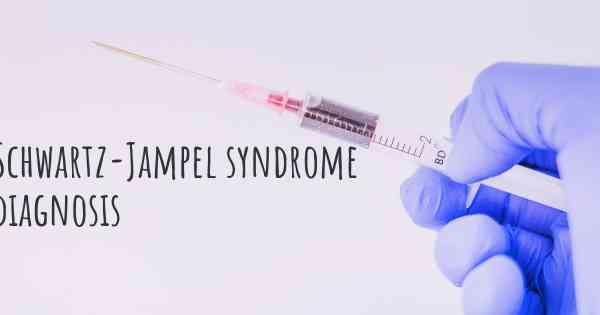How is Schwartz-Jampel syndrome diagnosed?
See how Schwartz-Jampel syndrome is diagnosed. Which specialists are essential to meet, what tests are needed and other useful information for the diagnosis of Schwartz-Jampel syndrome

Schwartz-Jampel syndrome (SJS), also known as chondrodystrophic myotonia, is a rare genetic disorder characterized by skeletal abnormalities and muscle stiffness. It is caused by mutations in the HSPG2 gene, which encodes for a protein called perlecan. Perlecan is involved in the development and maintenance of various tissues in the body, including cartilage and muscle.
Diagnosing Schwartz-Jampel syndrome can be challenging due to its rarity and the variability of symptoms among affected individuals. However, there are several key steps and diagnostic tools that healthcare professionals utilize to identify and confirm the presence of this condition.
Medical History and Physical Examination
The diagnostic process typically begins with a comprehensive medical history review. The healthcare provider will inquire about the patient's symptoms, their onset, and any relevant family history. It is crucial to identify any characteristic signs and symptoms associated with Schwartz-Jampel syndrome, such as:
- Muscle stiffness: Individuals with SJS often experience muscle stiffness, especially in the face, neck, and limbs. This stiffness can be present from birth or develop during early childhood.
- Skeletal abnormalities: Skeletal abnormalities are a hallmark of SJS and may include short stature, joint contractures (limited range of motion), scoliosis (curvature of the spine), and dysplasia (abnormal bone development).
- Facial dysmorphism: Some individuals with SJS exhibit distinct facial features, such as a small mouth, a flattened nasal bridge, and a high-arched palate.
- Ocular manifestations: Eye abnormalities, including ptosis (drooping eyelids), myopia (nearsightedness), and corneal clouding, can be present in SJS.
After obtaining a detailed medical history, a thorough physical examination is conducted. The healthcare provider will assess the patient's muscle tone, joint mobility, and look for any characteristic physical features associated with SJS. They may also evaluate the patient's ocular health and perform additional tests to assess muscle strength and function.
Genetic Testing
Genetic testing plays a crucial role in diagnosing Schwartz-Jampel syndrome. It involves analyzing the patient's DNA to identify mutations in the HSPG2 gene. Genetic testing can be performed using various techniques, including:
- Sanger sequencing: This method involves sequencing specific regions of the HSPG2 gene to identify potential mutations.
- Next-generation sequencing (NGS): NGS techniques allow for the simultaneous sequencing of multiple genes, including the HSPG2 gene. It provides a more comprehensive analysis of the patient's genetic makeup.
- Whole exome sequencing (WES): WES involves sequencing the protein-coding regions of all genes in the genome. It can help identify mutations in genes not initially suspected to be associated with SJS.
Genetic testing can confirm the presence of mutations in the HSPG2 gene, providing a definitive diagnosis of Schwartz-Jampel syndrome. It can also help differentiate SJS from other conditions with similar symptoms.
Electromyography (EMG)
Electromyography (EMG) is a diagnostic procedure that measures the electrical activity of muscles. It can be useful in evaluating muscle function and identifying abnormalities associated with Schwartz-Jampel syndrome. During an EMG, small electrodes are inserted into the muscles, and the electrical signals generated by muscle contractions are recorded and analyzed.
In individuals with SJS, EMG findings may reveal myotonic discharges, which are abnormal electrical patterns indicative of muscle stiffness and myotonia. EMG can also help differentiate between muscle stiffness caused by Schwartz-Jampel syndrome and other neuromuscular disorders.
Other Diagnostic Tests
In addition to the aforementioned methods, healthcare professionals may utilize other diagnostic tests to further evaluate individuals suspected of having Schwartz-Jampel syndrome. These tests may include:
- Imaging studies: X-rays, magnetic resonance imaging (MRI), or computed tomography (CT) scans can help visualize skeletal abnormalities, joint contractures, and spinal deformities associated with SJS.
- Ophthalmologic examination: An ophthalmologist may perform a comprehensive eye examination to assess visual acuity, evaluate for corneal clouding, and identify other ocular abnormalities.
- Cardiac evaluation: Some individuals with SJS may have cardiac abnormalities, such as hypertrophic cardiomyopathy. Cardiac evaluations, including electrocardiograms (ECGs) and echocardiograms, may be conducted to assess heart function.
It is important to note that the specific diagnostic approach may vary depending on the individual's symptoms, clinical presentation, and available resources. A multidisciplinary team of healthcare professionals, including geneticists, neurologists, orthopedic specialists, and ophthalmologists, may collaborate to ensure an accurate diagnosis of Schwartz-Jampel syndrome.
In conclusion, diagnosing Schwartz-Jampel syndrome involves a combination of medical history review, physical examination, genetic testing, electromyography, and other diagnostic tests. The identification of characteristic signs and symptoms, along with the detection of mutations in the HSPG2 gene, is crucial for confirming the diagnosis. Early diagnosis is essential for appropriate management and support of individuals with Schwartz-Jampel syndrome.








